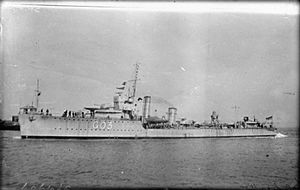HMS Vortigern (D37) facts for kids

Vortigern in the First World War
|
|
Quick facts for kids History |
|
|---|---|
| Name | HMS Vortigern |
| Ordered | 1916-17 Programme Build (9th Order) |
| Builder | J. Samuel White, Cowes, Isle of Wight |
| Laid down | 17 January 1917 |
| Launched | 5 October 1917 |
| Commissioned | 21 January 1918 |
| Identification | Pennant number: D37 |
| Motto | Virtus a majoribus : 'Our valour is from our ancestors' |
| Honours and awards |
|
| Fate | Sunk by E-boats on 15 March 1942 |
| Badge | On a Field Red, an ancient British Sword, hilt Gold, blade Silver |
| General characteristics | |
| Class and type | V-class destroyer |
| Displacement | 1,272-1,339 tons |
| Length |
|
| Beam | 26 ft 9 in (8.2 m) |
| Draught |
|
| Propulsion |
|
| Speed | 34 kn |
| Range |
|
| Complement | 110 |
| Armament |
|
The HMS Vortigern was a powerful warship known as a V-class destroyer. She was part of the Royal Navy, which is Britain's navy. This ship bravely served in both World War I and World War II. Sadly, she was sunk in 1942 during a battle.
Contents
Building a Warship: HMS Vortigern
HMS Vortigern was ordered during World War I from a company called J. Samuel White. This company was located in Cowes, on the Isle of Wight in England.
The ship's construction began on 17 January 1917. She was officially launched into the water on 5 October 1917. The Vortigern was ready for duty and joined the Royal Navy on 21 January 1918. She was named after Vortigern, an ancient British ruler. So far, she is the only Royal Navy ship to have this name.
Service in Two World Wars
HMS Vortigern continued to serve for the rest of World War I. After the war, in 1919, she was sent to the Baltic Sea. Later, she joined a group of ships called the 1st Destroyer Flotilla.
Eventually, the ship was put into reserve, meaning she was kept ready but not actively used. However, in 1939, she was brought back into service. This was so she could take part in a special event. She joined other reserve ships for a Fleet Review by King George VI.
World War II Duties
When World War II began, Vortigern was assigned to the 17th Destroyer Flotilla. Her home base was in Plymouth, England. Her main jobs were to protect convoys (groups of supply ships) and hunt for enemy submarines. She carried out these duties in the English Channel and nearby waters throughout 1939.
In January 1940, Vortigern was chosen to join the 13th Destroyer Flotilla in Gibraltar. On 13 January, she helped escort a convoy of ships heading to Gibraltar. Once they arrived on 15 January, Vortigern joined her new flotilla. For the next few months, from February to June, she continued to escort convoys between Britain and Gibraltar.
Key Operations in 1940
On 3 July 1940, Vortigern was part of a major event. This was the attack on the French fleet at Mers-el-Kébir. A few days later, on 6 July, she helped protect a powerful group of British warships. This group included the battlecruiser HMS Hood and the aircraft carrier HMS Ark Royal. These ships were launching air attacks on the French battleship Dunkerque.
On 8 July, Vortigern joined other destroyers to protect the main warships again. This time, they were preparing for air attacks on Italian targets near Cagliari. However, this operation was stopped because the British ships came under heavy air attack themselves. Vortigern then sailed back to Britain on 12 July.
Protecting Convoys in Home Waters
In August, Vortigern was sent to protect convoys in British waters. She covered ships sailing to and from the River Clyde in Scotland. In September, she went into a shipyard for repairs and upgrades. She was changed into a "Short Range Escort" ship. This work finished in November.
After testing her new equipment, Vortigern joined the 12th Destroyer Flotilla. This group was based at Rosyth and protected convoys in the North Sea. On 9 December, while escorting a convoy, a German seaplane attacked Vortigern near Aldeburgh. Despite the attack, the destroyer continued her important patrols and convoy escort duties throughout 1941 and into 1942.
The Sinking of HMS Vortigern
HMS Vortigern was tragically sunk on 15 March 1942. She was off the coast of Cromer in England. At the time, she was bravely defending a coastal convoy from an attack by German E-boats (fast attack boats).
An E-boat named S104 fired a torpedo that hit Vortigern. The ship quickly sank. Out of her crew, 110 lives were lost. Only 14 sailors were rescued from the sea. The Cromer lifeboat H F Bailey III recovered eleven bodies from the water.
The place where Vortigern sank is now a special "Protected Place" under a law called the Protection of Military Remains Act 1986. This means the wreck site is protected. There are also twelve war graves in Lowestoft and one in the New Cromer town cemeteries for those lost from HMS Vortigern.

